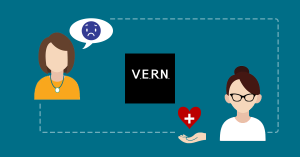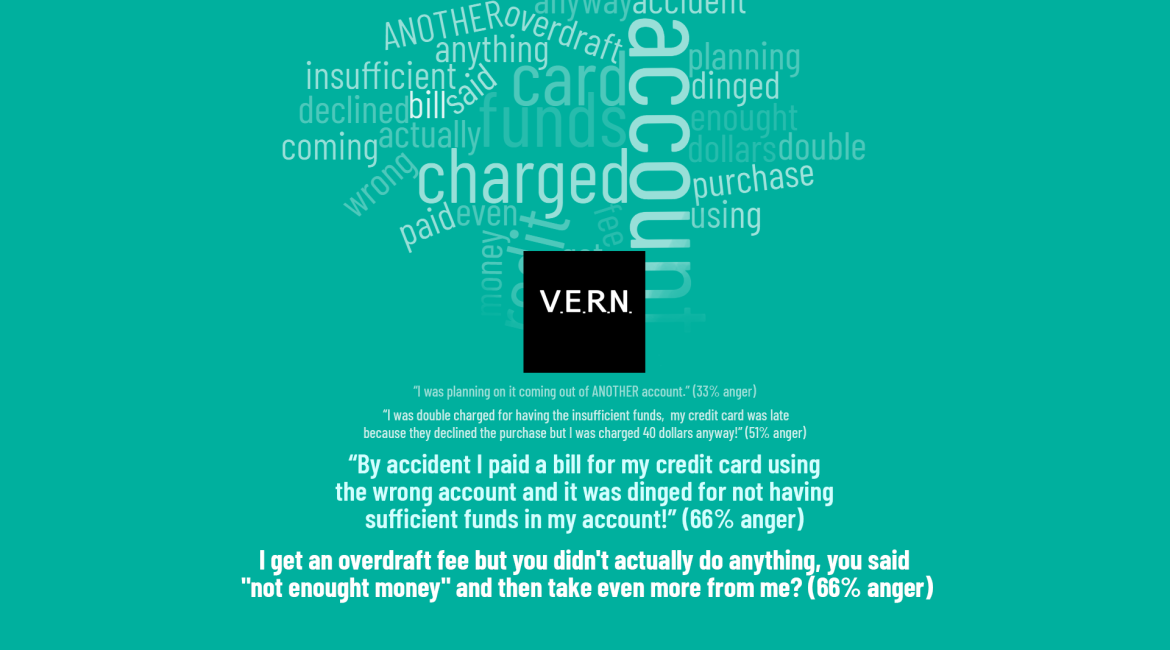 We’ve spent a lot of time talking about how V.E.R.N. can work to detect emotion, and different ways in which it can aid technology to build the future of interactions. We thought that for this blog post, we’d actually show you a few examples from various sources. Because, you know, seeing is believing.
We’ve spent a lot of time talking about how V.E.R.N. can work to detect emotion, and different ways in which it can aid technology to build the future of interactions. We thought that for this blog post, we’d actually show you a few examples from various sources. Because, you know, seeing is believing.
You’ll see examples from social media, news stories, product reviews, customer service, and therapeutics. It’s the closest thing to trying it for yourself.
While the model is in its infancy, it does show significant promise when we have applied it to different use cases. Nothing is perfect, but we strive to be the best we can be and improve through learning. We’ll disclose where we got it right, and where we got it wrong. Because transparency (as much as the lawyers will allow, of course) is key to the understanding of what V.E.R.N. is and how it can be useful.
VERN detects emotions in communication, and we provide a response to any query with a confidence level of the emotions present. 51% or more indicates a strong likelihood of the emotion being present. Anything closer to 100% of course strengthens that confidence, as more emotives are detected. So what you’ll see is the analysis of confidence VERN has in each example.
A fair warning: Some of these messages can be emotionally upsetting and represent the range of human emotions we encounter on a daily basis. Some of what is to follow is not for the faint of heart.
SOCIAL MEDIA CONTENT
First, we’re presenting a social media post from a publicly posted conversation in an online forum. The author is a male, in their early 20s, from the southern United States.
I think it feels f***** up to me that hardly anyone has offered to help me in the last one and half months with being homeless while I’m waiting for a home to open up of my own. They all have waiting lists. No…just let me be homeless. So Heartless. Thank you so much to the two people who live too far away who offered to let us stay. I’m grateful. Too bad gratitude doesn’t pay the thousands of dollars hotel bills. Just let me go broke from all my hard earned money. I don’t deserve this
VERN ANALYSIS
As we can see from the example, the person is certainly sending a lot of emotional communication in the content. Several instances appear to be sarcastic, somewhat sardonic and overall would be intended to portray a dysphoric emotional state. It’s also quite revealing that we often see “mixed” emotions for what they are-more complex emotional states. Now, for the first time we can see “mixed” emotions for what they are:
“I think it feels f****** up to me that hardly anyone has offered to help me in the last 1.5 months with being homeless while I’m waiting for a home to open of my own.” (66% Sadness, 80% anger, 66% humor).
“No…just let me be homeless.” (12.5% Sadness, 33% Anger, 66% humor)
“Thank you so much to the two people who live too far away who offered to let us stay.” (33% Sadness, 33% Anger, 97% Humor)
“Just let me go broke from all my hard earned money.” (51% Sadness, 33% Anger, 66% Humor)
“I don’t deserve this.” (33% Sadness, 51% Anger, 12.5% Humor)
In the interest of full disclosure, VERN did not pick up possible emotions in the sentences:
“They all have waiting lists”, “Too bad gratitude doesn’t pay the thousands of dollars hotel bills,” “So Heartless…” and “I’m grateful.”
 The first sentence doesn’t appear to be anything other than a statement of fact. The next sentence was close to anger and humor but didn’t cross the threshold at 33%. To a human reader, it may be interpreted as thinly veiled contempt, or merely a statement of fact. Gratitude doesn’t actually pay hotel bills. It’s close, but no cigar.
The first sentence doesn’t appear to be anything other than a statement of fact. The next sentence was close to anger and humor but didn’t cross the threshold at 33%. To a human reader, it may be interpreted as thinly veiled contempt, or merely a statement of fact. Gratitude doesn’t actually pay hotel bills. It’s close, but no cigar.
“So heartless.” …That’s a miss. So it’s back to the lab to pick that one apart. The next sentence of “I’m grateful” didn’t ring any bells for any of VERN’s detectors. It could be sincere, or it could be sarcastic. That could be intentionally covering the emotion, as the author probably didn’t want to offend those who did offer sincere help.
Clearly, the author intended this as an emotional plea.
Breaking News!
Okay, alright…so it’s not the top or bottom of the hour on your favorite news source. (i.e., It’s not really breaking news). But it does allow for me to awkwardly attempt to segue into a new topic…and gives us an opportunity to show you how VERN analyzes professionally crafted communication. This time, it’s by journalists covering a potentially emotional subject. We will only provide an excerpt. (The link to the rest of the story is in the reference list below).
In a recent article on the effects of COVID-19, the Associated Press ran an article on November 19th, 2020 about the deaths attributed to nursing home neglect during the pandemic. Here is an excerpt, with our analysis:
When COVID-19 tore through Donald Wallace’s nursing home, he was one of the lucky few to avoid infection. He died a horrible death anyway.
VERN ANALYSIS
“When COVID-19 tore through Donald Wallace’s nursing home, he was one of the lucky few to avoid infection.” (33% Sadness, 0% Anger, 0% Humor).
“He died a horrible death anyway.” (51% Sadness, 12.5% Anger, 0% Humor)
“Hale and happy before the pandemic, the 75-year-old retired Alabama truck driver became so malnourished and dehydrated that he dropped to 98 pounds and looked to his son like he’d been in a concentration camp.” (12.5% Sadness, 12.5% Anger, 0% Humor)
 The Associated Press, who just recently celebrated 175 years in business, is notoriously and strenuously objective in their writing. Their style guide is a must have for professional writers, specifically for journalists. Most of the content is staid, and professional. Occasionally, as you can see in the example above, there is a bit of emotion that does seep into journalism. It’s story, after all. And the story has to be interesting to other humans.
The Associated Press, who just recently celebrated 175 years in business, is notoriously and strenuously objective in their writing. Their style guide is a must have for professional writers, specifically for journalists. Most of the content is staid, and professional. Occasionally, as you can see in the example above, there is a bit of emotion that does seep into journalism. It’s story, after all. And the story has to be interesting to other humans.
The fact that Mr. Wallace died a horrible death anyway, after avoiding COVID-19, is sad. We’d rank that as an objectively sad statement. There are a few here and there that we’ve detected in the thousands of lines of news articles we’ve analyzed. Funny thing is, most articles turn out like the example above: Few emotives, as the authors are (mostly) communicated fact devoid of feelings that would impart bias.
PRODUCT REVIEWS
 Product and business reviews are a big part of life, and any business that ignores the reviews does so at their own peril. It’s been found that people are increasingly turning to online reviews for input in making their purchase decisions. No big deal, right? Well, what about if we told you that users are trusting information from individuals that they have a comparatively weak bond, instead of friends and family? The old paradigm of weak and strong bonds determining the validity of information may be fraying.
Product and business reviews are a big part of life, and any business that ignores the reviews does so at their own peril. It’s been found that people are increasingly turning to online reviews for input in making their purchase decisions. No big deal, right? Well, what about if we told you that users are trusting information from individuals that they have a comparatively weak bond, instead of friends and family? The old paradigm of weak and strong bonds determining the validity of information may be fraying.
It also means that the customer reviews are more important than ever.
So let’s take a look at a product review, and use one of the examples that a big tech company uses to demonstrate the power of its tools. First, the review itself.
I just wanted to find some really cool new places I’ve never visited before but no luck here. Some of these suggestions are just terrible…I had to laugh! Most suggestions were just your typical big cities, restaurants and bars. Nothing off the beaten path here. I don’t want to go these places for fun. Totally not worth getting this!
Sounds like someone was reasonably disappointed with the suggestions provided by the product. And, in the paragraph we can probably detect some emotions present. It’s certainly negative, like the sentiment tool scores:
NEGATIVE: 0.72
MIXED: 0.17
POSITIVE: 0.06
NEUTRAL: 0.05
And yeah, the big tech tool shows that it is indeed negative. But it’s also mixed. And a tiny bit positive. With some neutral mixed in. Neat.
So…what exactly is the customer upset about?
I just wanted to find some really cool new places I’ve never visited before but no luck here. (51% anger, 90% humor)
Some of these suggestions are just terrible… I had to laugh! (51% anger, 66% humor)
Most suggestions were just your typical big cities, restaurants and bars. (12.5% anger, 51% humor)
Nothing off the beaten path here. (33% anger, 0% humor)
I don’t want to go these places for fun. (12.5% anger, 33% humor)
Totally not worth getting this! (12.5% anger, 0% humor)
From the VERN analysis we can clearly answer that question: The customer is upset that they wanted to find some cool new, out of the ordinary places to visit and did not find what they were looking for. They found it somewhat humorous that the suggestions were typical, which would indicate that the person had different expectations. A review with this level of analysis, may make it a lot easier to identify problems when you know exactly what they are.
And, with VERN you can quickly analyze reams of reviews in no time. Or, respond to them as they come in.
Send upset customers coupons and apologies; or send fans promos and social media love.
CUSTOMER SERVICE
 We have tested VERN on customer service queries, inbound communication, internal messaging, and basically anything we could get our hands on in regards to customer service or interpersonal interactions. The particular use case you are looking at is application of the Anger detector by itself. This would help to triage the problem by detecting the level of aner emotion present in the message, and escalating it automatically to a higher level of customer support.
We have tested VERN on customer service queries, inbound communication, internal messaging, and basically anything we could get our hands on in regards to customer service or interpersonal interactions. The particular use case you are looking at is application of the Anger detector by itself. This would help to triage the problem by detecting the level of aner emotion present in the message, and escalating it automatically to a higher level of customer support.
Here’s a recent example from customer service that we ran into, with the VERN analysis:
I get an overdraft fee but you didn’t actually do anything, you said “not enough money” and then take even more from me?
VERN ANALYSIS
“I was double charged for having the insufficient funds, my credit card was late because they declined the purchase but I was charged 40 dollars anyway” (51% anger)
“By accident I paid a bill for my credit card using the wrong account and it was dinged for not having sufficient funds in my account!” (66% anger)
“I get an overdraft fee but you didn’t actually do anything, you said “not enough money” and then take even more from me?” (66% anger)
Using this analysis, it allows for the organization to identify common complaints and strategize communications to assuage customers and soothe feelings. Perhaps by using emotional recognition to unlock previously unseen emotions, that there may be an opportunity for insight into a nagging problem, or provide an idea for a unique value proposition. If one person feels this way, that’s one thing. If several people feel this way, that’s another. Some things will anger people less than others.
Isn’t that important to know about how your customers feel about you?
If you were to track emotions in the text using emotion recognition you may see a trend over time. Perhaps immediately. If you had the ability, you could potentially monitor how well your customer service initiatives are doing by the emotions people provide you.
It sure beats positive, negative, neutral and mixed.
THERAPEUTICS

Perhaps one of the most intriguing applications of an automated, objective software that detects latent emotional clues is in helping professionals understand others. Emotion recognition is important in emotional intelligence, surely, but it appears that it’s also important in designing software to interact with humans as well.
It may actually improve patient care.
What follow are a collection of messages that were communicated when people were expressing (and some cases broadcasting) their emotions on social media.
That moment when you burst into tears in your room and you realize that no one knows how unhappy, depressed and sucks you are.
VERN ANALYSIS
“When you lose a person you love so much, surviving the loss is difficult.” (51% sadness, 12.5% anger, 12.5% humor)
“Fortunately, I avoided this sort of embarrassment, because no girls ever called me.” (33% sadness: 66% anger, 51% humor)
“”yOu LoOk sAd” bitch i’m depressed” (80% sadness, 66% anger, 51% humor)
“Yep I’m sad and now I wanna eat all of my feelings thanks” (51% sadness, 51% anger, 33% humor)
“That moment when you burst into tears in your room and you realize that no one knows how unhappy, depressed and sucks you are.” (80% sadness, 80% anger, 66% humor)
We can see how VERN could assist in patient intake forms, questionnaires, or part of virtual screening and video conferencing. It potentially could greatly improve patient care. For more information on how VERN can help in medicine and therapy check out our blog.

